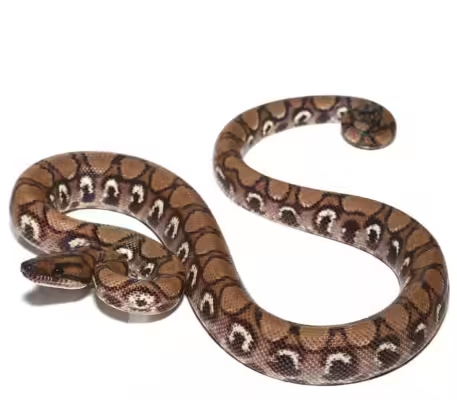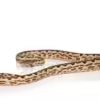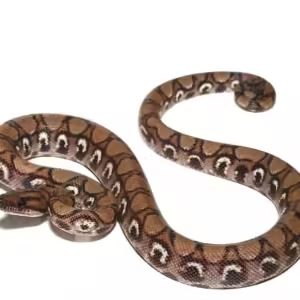Anery Brazilian Rainbow Boa For Sale
$799.99
WE HAVE ANERY BRAZILIAN RAINBOW BOA FOR SALE. HERE ARE SOME HIGHLIGHTS:
- Epicrates cenchria
- Captive Bred Female
- Approximately 28 – 34 Inches In Length From Head To Tail
- Adults Can Reach Up To 6-7 Feet In Total Length
- Feeding On Small Rats Weekly
FUN FACTS!
- These Snakes Get Their Names From Their Iridescent Scales That Make Them Shimmer In The Sun
- Tropical Species That Requires High Humidity, Add Sphagnum Moss To Their Substrate
- This Boa Comes From South America In The Amazon Basin Ranging From Coastal Guyana, French Guiana, Suriname, And Southern Venezuela
- With Good Care These Snakes Can Live Up To 20 Years In Captivity
Anery Brazilian Rainbow Boa
The Anery Brazilian Rainbow Boa is a captivating and unique morph of the Brazilian Rainbow Boa (Epicrates cenchria). This particular morph is distinguished by its lack of red and orange pigmentation, giving it a striking, silvery-gray appearance. The term “anery” is short for anerythristic, which refers to the absence of red coloration. This morph is particularly admired for its iridescent sheen, which can create an enchanting display of colors under certain lighting conditions.
Originating from the vast and diverse Amazon Basin, the Brazilian Rainbow Boa thrives in the humid, tropical climate of this region. The Amazon Basin provides a rich ecosystem with dense foliage, abundant water sources, and a plethora of prey items, making it an ideal environment for these snakes. The Anery Brazilian Rainbow Boa, like its counterparts, is adept at navigating this complex habitat, utilizing its slender, muscular body to climb trees and swim efficiently.
In recent years, the Anery Brazilian Rainbow Boa has gained significant popularity among reptile enthusiasts and breeders. Its unique coloration and striking appearance make it a sought-after addition to many collections. Additionally, the boa’s relatively manageable size, typically reaching 5 to 7 feet in length, and its generally docile nature contribute to its appeal as a pet. Enthusiasts appreciate the combination of its visual allure and the manageable care requirements.
Understanding the natural habitat and origins of the Anery Brazilian Rainbow Boa is essential for providing optimal care in captivity. By replicating the humidity levels, temperature ranges, and environmental features of the Amazon Basin, keepers can ensure their boas thrive. This foundational knowledge sets the stage for a deeper exploration into the care, behavior, and breeding of the Anery Brazilian Rainbow Boa, which will be further discussed in subsequent sections of this comprehensive guide.
Physical Characteristics and Coloration
The Anery Brazilian Rainbow Boa, a distinct morph of the Brazilian Rainbow Boa, is renowned for its unique physical characteristics. One of the most striking features of this snake is its size, typically ranging from 4 to 6 feet in length, making it a medium-sized boa. Its body is robust and muscular, yet relatively slender, allowing for graceful movement through its natural habitat.
The texture of the Anery Brazilian Rainbow Boa’s scales is smooth and glossy, providing a sleek appearance that is visually appealing. These scales are tightly arranged, contributing to the snake’s streamlined physique. The iridescent sheen that is a hallmark of the Brazilian Rainbow Boa is still present, but it is more subdued in the anerythristic morph.
What truly sets the Anery Brazilian Rainbow Boa apart is its coloration. Unlike the typical Brazilian Rainbow Boa, which displays a vibrant array of rainbow hues thanks to the presence of red pigment, the Anery morph lacks this red pigment. This genetic anomaly, known as anerythrism, results in a color palette dominated by shades of grey and silver. The absence of red pigment causes the snake to exhibit a more monochromatic appearance, with patterns of black, white, and grey creating a striking contrast.
The genetic basis for this unique coloration lies in the absence of erythrin, the pigment responsible for red and orange hues. In anerythristic snakes, a recessive gene prevents the production of erythrin, leading to the distinctive grey and silver coloration. This genetic trait must be inherited from both parents, making the Anery Brazilian Rainbow Boa a fascinating subject of study for genetic enthusiasts and breeders alike.
In summary, the Anery Brazilian Rainbow Boa’s physical characteristics and coloration make it a captivating and distinctive morph. Its size, scale texture, and unique shades of grey and silver set it apart from other morphs, highlighting the diverse beauty within the species.
Habitat and Natural Environment
The Anery Brazilian Rainbow Boa, scientifically known as Epicrates cenchria, is a fascinating species native to the lush, diverse ecosystems of the Amazon Basin. This region, renowned for its dense rainforests, offers a unique environment that greatly influences the behavior and physiology of these snakes. The Amazon Basin features a tropical climate, characterized by high humidity and consistent temperatures ranging from 25°C to 30°C (77°F to 86°F) throughout the year. This stable climate plays a critical role in the life cycle of the Anery Brazilian Rainbow Boa.
Within this verdant expanse, the vegetation is dense and varied, providing ample cover and climbing opportunities for these semi-arboreal reptiles. The thick canopy and underbrush form an intricate habitat where the boas can find shelter. They often seek refuge in hollow logs, beneath leaf litter, and within the roots of large trees. This preference for concealed spaces helps them avoid predators and ambush prey, showcasing their adaptability to the forest environment.
The Anery Brazilian Rainbow Boa is primarily nocturnal, becoming most active during the cooler, darker hours of the night. This nocturnal activity pattern minimizes exposure to daytime heat and predators, while also aligning with the activity of many of their prey species, such as rodents, birds, and small mammals. The constant warm and humid conditions of the Amazon Basin are essential to their health, influencing their thermoregulation, skin shedding, and overall metabolic processes.
Furthermore, the ecosystem of the Amazon Basin is teeming with biodiversity, creating a complex web of interactions that the Anery Brazilian Rainbow Boa is intricately a part of. Their role as both predator and prey within this ecosystem highlights their importance in maintaining the balance of their natural habitat. Understanding the natural environment of the Anery Brazilian Rainbow Boa not only provides insights into their behavior and physiology but also underscores the significance of preserving these critical habitats for the continued survival of this captivating species.
Diet and Feeding Habits
The Anery Brazilian Rainbow Boa, a captivating and unique serpent, has specific dietary needs that are essential for its health and well-being. In its natural habitat, the Anery Brazilian Rainbow Boa primarily preys on a variety of small mammals and birds. Rodents such as mice and rats constitute a significant portion of their diet, while occasionally, they may also consume small avian species. This carnivorous diet provides the necessary nutrients for their growth and vitality.
Replicating this diet in captivity is crucial for maintaining the health of the Anery Brazilian Rainbow Boa. In a controlled environment, these boas can be fed a diet primarily consisting of appropriately sized rodents. It is important to select prey items that are proportional to the snake’s size; typically, the prey should be no larger than the widest part of the boa’s body. This ensures that the snake can swallow and digest the food without any complications.
When discussing feeding frequency, juvenile Anery Brazilian Rainbow Boas may require more frequent feedings, approximately once every 5-7 days, to support their rapid growth. Adult boas, on the other hand, can be fed less frequently, typically every 10-14 days. It is essential to monitor the snake’s body condition and adjust feeding schedules accordingly to prevent under or overfeeding. Overfeeding can lead to obesity, while underfeeding can result in malnutrition and related health issues.
Proper nutrition is paramount for the Anery Brazilian Rainbow Boa. Supplementing their diet with occasional vitamins and minerals can help ensure they receive all necessary nutrients. Additionally, providing fresh water at all times is crucial, as hydration plays a significant role in digestion and overall health. By closely observing the feeding habits and dietary needs of the Anery Brazilian Rainbow Boa, keepers can maintain a healthy and thriving snake.
Behavior and Temperament
The Anery Brazilian Rainbow Boa exhibits a distinctive behavior and temperament that make it a fascinating subject for both herpetologists and snake enthusiasts. Typically, these boas are known for their generally docile nature, which makes them relatively easy to handle compared to other snake species. When kept in captivity, they often adapt well to human interaction, provided that they are handled gently and regularly from a young age. This helps in mitigating any initial skittishness and fosters a bond between the snake and its owner.
In their natural habitat, Anery Brazilian Rainbow Boas are nocturnal creatures, preferring to hunt and explore during the night. This nocturnal activity means that they are more active and can be observed exhibiting a range of behaviors during the evening hours. In captivity, it is beneficial to simulate a natural day-night cycle to accommodate their nocturnal tendencies, which can help in reducing stress and promoting overall well-being.
When it comes to interaction with other snakes, Anery Brazilian Rainbow Boas can coexist with other snakes of similar size and temperament, although it is generally recommended to house them individually to prevent competition for resources and reduce stress. Recognizing signs of stress or illness in these snakes is crucial for maintaining their health. Common indicators include loss of appetite, unusual lethargy, and changes in behavior such as increased aggression or hiding more frequently than usual. Regular health check-ups with a reptile veterinarian can preemptively address any potential health issues.
Handling tips for owners include supporting the snake’s body fully during handling sessions and avoiding sudden movements that may startle it. Observing the snake’s body language is essential; a relaxed boa will move smoothly and calmly, whereas a stressed one may exhibit rapid, jerky movements or attempt to hide. By understanding and respecting the behavioral and temperamental traits of the Anery Brazilian Rainbow Boa, owners can ensure a harmonious and enriching experience for both the snake and themselves.
Housing and Enclosure Requirements
The proper housing and enclosure setup for an Anery Brazilian Rainbow Boa is crucial for its health and well-being. To begin with, the size of the enclosure must be appropriate for the snake’s size. A juvenile Anery Brazilian Rainbow Boa can be comfortably housed in a 20-gallon tank, but as it matures, a larger enclosure will be necessary. An adult boa typically requires a minimum of a 40-gallon tank, though larger enclosures are preferred to allow for ample movement and exploration.
Temperature and humidity are critical factors in replicating the natural environment of the Anery Brazilian Rainbow Boa. The enclosure should have a temperature gradient ranging from 75°F to 85°F, with a basking spot that reaches up to 90°F. This gradient allows the snake to regulate its body temperature by moving between warmer and cooler areas. Nighttime temperatures can safely drop to around 70°F. Humidity levels should be maintained between 70% and 80%, as these boas thrive in a humid environment. Regular misting and the use of a hygrometer can help ensure that these levels are consistently met.
The choice of substrate is another important consideration. Ideal substrates include cypress mulch, coconut husk, or sphagnum moss, all of which retain moisture well, helping to maintain the necessary humidity levels. Avoid substrates that can cause impaction, such as gravel or sand.
Creating a stimulating environment for the Anery Brazilian Rainbow Boa involves incorporating various hiding spots and climbing structures. Hides can be as simple as commercially available reptile hides or creatively crafted from natural materials like cork bark and hollow logs. Climbing structures can include branches and vines, encouraging the snake’s natural climbing behavior. These environmental enrichments not only mimic the boa’s natural habitat but also promote physical and mental well-being.
By carefully considering these housing and enclosure requirements, owners can ensure their Anery Brazilian Rainbow Boa thrives in captivity, enjoying a healthy and enriched life.
Health and Common Issues
The health and well-being of an Anery Brazilian Rainbow Boa are paramount for its longevity and quality of life. A healthy boa exhibits bright, clear eyes, a smooth and shiny scale pattern, and a regular appetite. It’s essential to be vigilant for any signs of health issues, as early detection can significantly impact the effectiveness of treatment.
One of the most common health problems in Anery Brazilian Rainbow Boas is respiratory infections. Symptoms include wheezing, excessive mucus, open-mouth breathing, and lethargy. These infections often stem from improper humidity levels or poor enclosure hygiene. Ensuring that the habitat maintains appropriate temperature and humidity can help prevent these issues. Additionally, regular cleaning of the enclosure will minimize the growth of harmful bacteria and fungi.
Another prevalent issue is scale rot, a bacterial infection that affects the skin and scales. This condition is typically caused by prolonged exposure to a damp or dirty environment. Signs of scale rot include discolored, blistered, or necrotic scales. To prevent scale rot, it’s crucial to maintain a clean and dry substrate, as well as to provide a water dish that can be easily accessed but not easily spilled. If scale rot occurs, immediate veterinary intervention is necessary to prevent the infection from spreading.
Preventive care is essential in maintaining the health of your Anery Brazilian Rainbow Boa. Regular health checks can help identify potential issues before they become serious. Observe your boa’s behavior and physical condition routinely, and seek veterinary assistance if you notice any abnormalities.
Proper hygiene practices are also vital, especially when introducing new additions to your collection. Quarantine new boas for at least 60 days in a separate enclosure to monitor for any signs of illness. This practice helps prevent the spread of diseases and ensures the health of your existing boas.
By adhering to these guidelines and remaining attentive to your boa’s health, you can help ensure a long and healthy life for your Anery Brazilian Rainbow Boa.
Breeding and Reproduction
The breeding and reproduction of the Anery Brazilian Rainbow Boa require careful planning and understanding of their unique needs. Successful breeding begins with the selection of compatible pairs. It’s essential to ensure both the male and female boas are in optimal health, with no signs of illness or malnutrition. Breeding typically occurs during the cooler months, and it’s advisable to slightly lower the temperature in their enclosure to mimic their natural environment and stimulate breeding behavior.
Once a pair is introduced, copulation may occur multiple times over several days or weeks. Observing the pair during this period is crucial to ensure no signs of aggression or stress. Post-copulation, the female enters a gestation period, which can vary from 120 to 150 days. During this time, maintaining a stable environment with appropriate temperature and humidity levels is vital for the health of the pregnant female.
The birthing process of the Anery Brazilian Rainbow Boa is an extraordinary event. Unlike many reptiles, these boas give birth to live young rather than laying eggs. A gravid female will typically give birth to a litter of 12 to 25 neonates. It’s important to provide a clean, secure space for the birthing process, ensuring minimal stress and intervention.
Caring for newborn Anery Brazilian Rainbow Boas requires meticulous attention. Neonates should be housed individually in small, secure enclosures to prevent potential injuries and to monitor their health closely. The initial feeding should occur after their first shed, which usually happens within a week of birth. Offering appropriately-sized prey items, such as pinky mice, ensures proper nutrition for growth and development.
Ensuring the health of the mother post-birth is equally important. She should be monitored for any signs of retained offspring or other complications. Providing a balanced diet and a stress-free environment aids in her recovery. With diligent care and attention to detail, breeding and raising Anery Brazilian Rainbow Boas can be a rewarding experience for any reptile enthusiast.



















Reviews
There are no reviews yet.